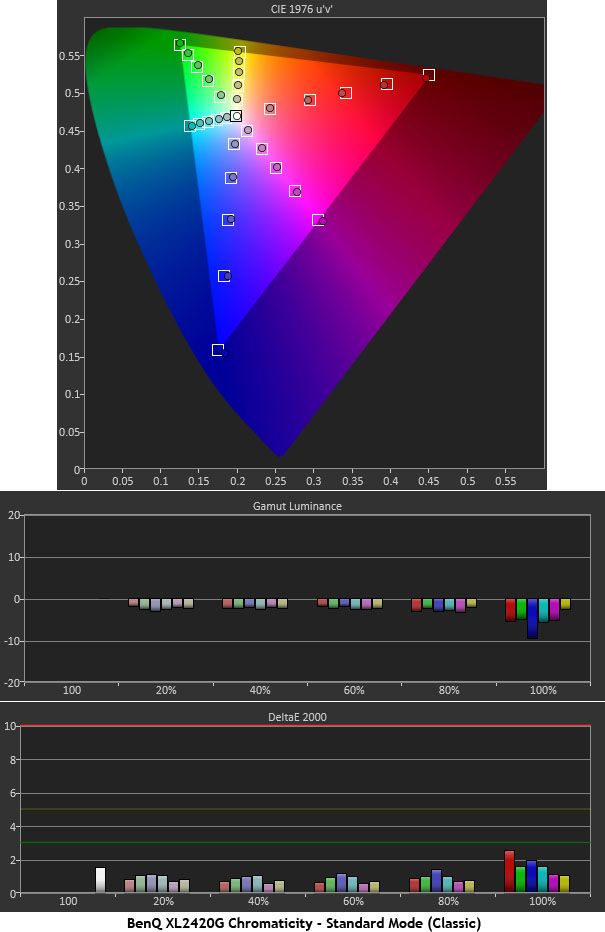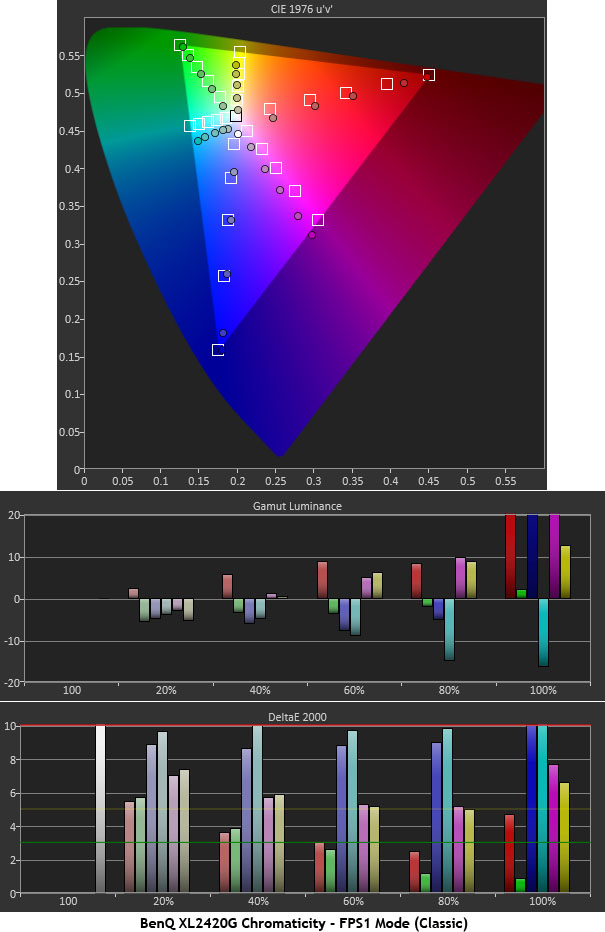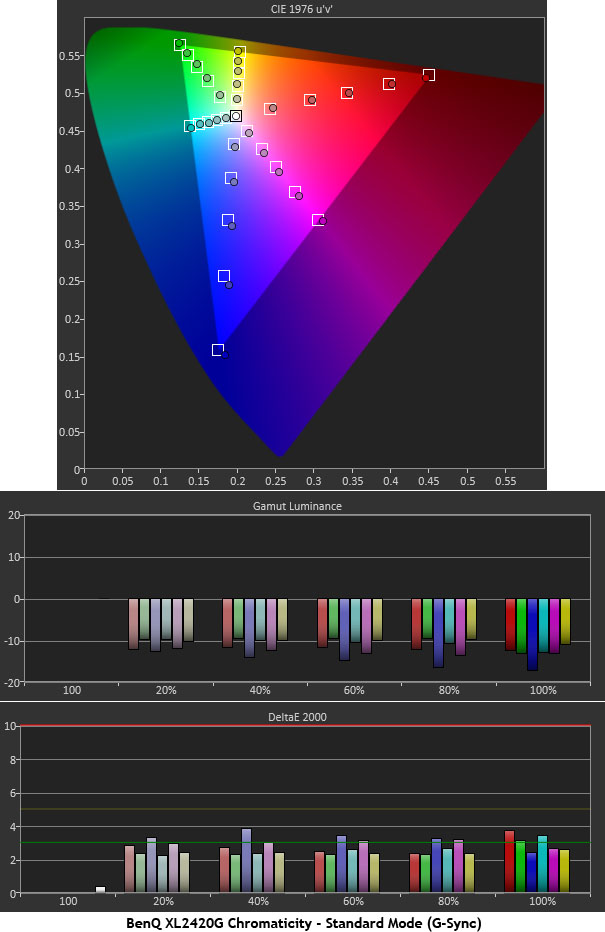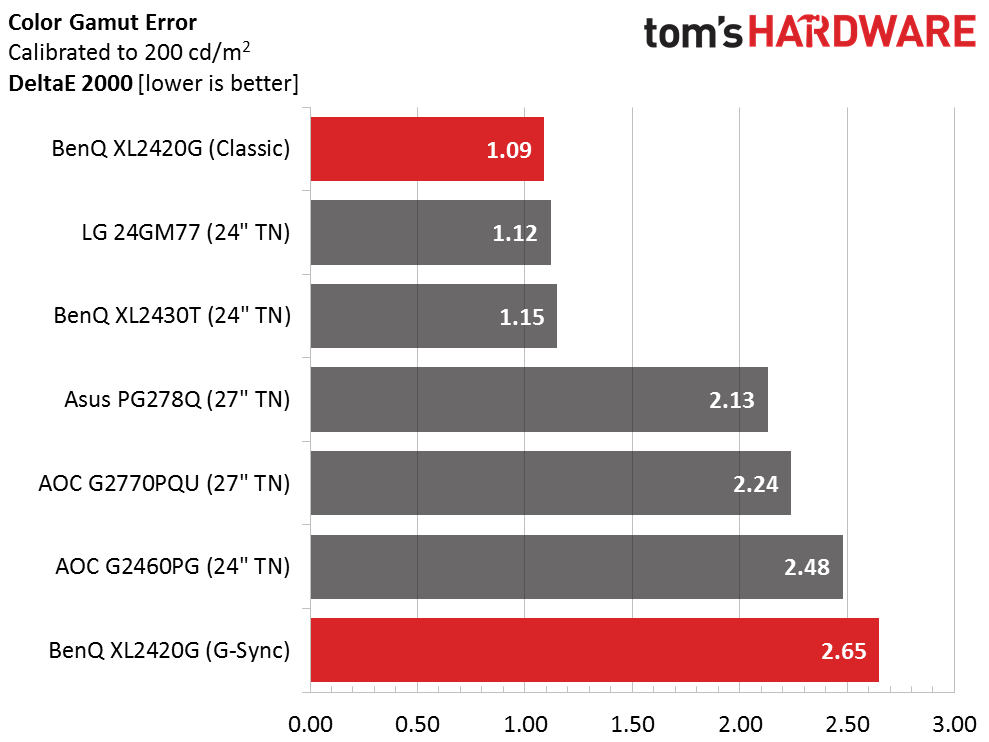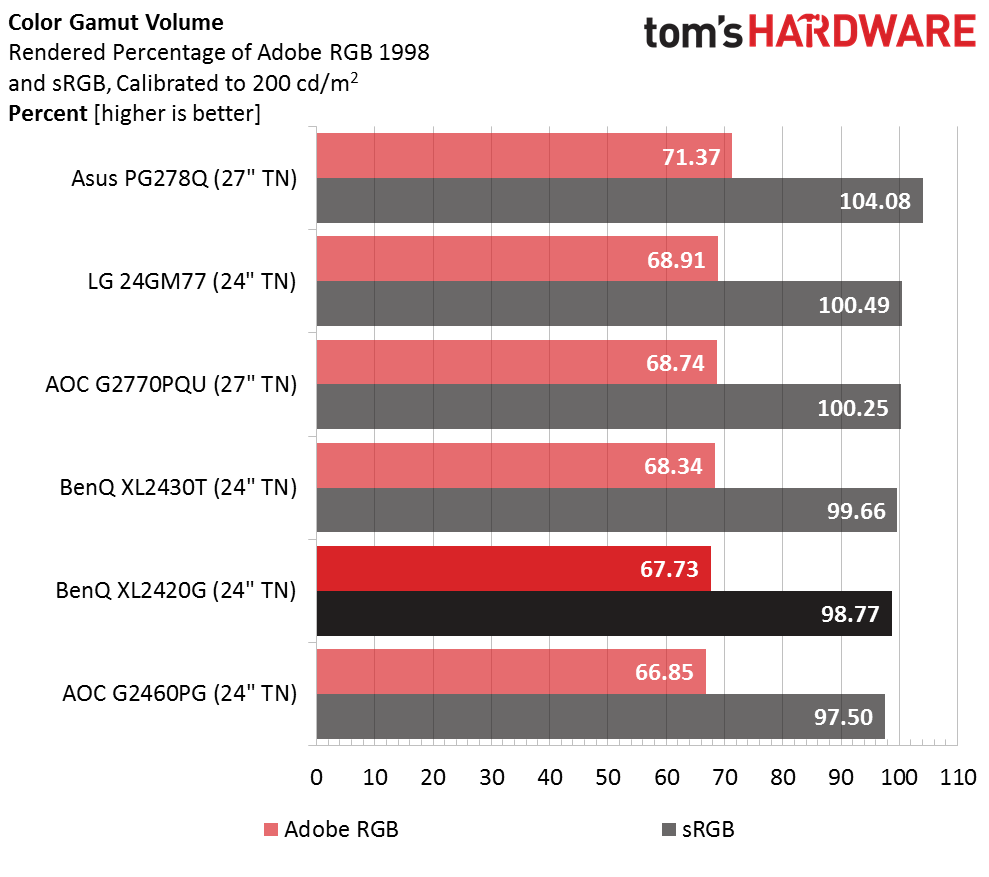BenQ XL2420G G-Sync Monitor Review
Even though FreeSync is starting to appear, G-Sync is still the go-to tech for gamers seeking an image free of frame-tearing. Today we’re checking out BenQ’s latest feature-laden display – the 24-inch XL2420G.
Why you can trust Tom's Hardware
Color Gamut And Performance
For details on our color gamut testing and volume calculations, please click here.
Whether you calibrate or not, the XL2420G’s color performance is exemplary. The CIE and luminance charts are about as close to perfect as you can get, and that’s reflected in a DeltaE result that's well below the threshold of visibility. The chart above represents the Standard picture preset in Classic mode.
Color takes a fairly wild ride in the FPS1 mode. Everything except for red shows under-saturation, and there are hue errors in magenta and cyan. Yellow saturation is the same at both 80 and 100 percent, which means the brightest hues are deficient in that color. We should be seeing higher luminance values to compensate, but they are off the mark as well. The resulting error averages 6.66 DeltaE, with some as high as 10dE.
While the color is OK in G-Sync mode, it isn’t quite as tight as Classic. The CIE chart looks good; all of the colors and saturations are on or near their targets. Luminance is the only flawed attribute, exhibiting generally low values throughout. In actual content, you’ll see a slightly less vivid picture than what you get from Classic mode. Fixing the gamma tracking in firmware would have a positive impact on the color results, we think.
Now we return to the comparison group:
The Classic mode measures well, with results rivaling the best professional displays. G-Sync mode is a little weaker compared to our other screens, but a 2.65dE average is still pretty low. Overall, we have no real issue with color accuracy in either mode.
Gamut Volume: Adobe RGB 1998 And sRGB
All of these gaming monitors come close to 100-percent sRGB volume, with Asus offering a four-percent bonus. In Classic mode, the XL2420G can easily be used for color-critical work given its excellent color and grayscale accuracy.
Get Tom's Hardware's best news and in-depth reviews, straight to your inbox.
Current page: Color Gamut And Performance
Prev Page Grayscale Tracking And Gamma Response Next Page Viewing Angles, Uniformity, Response And Lag
Christian Eberle is a Contributing Editor for Tom's Hardware US. He's a veteran reviewer of A/V equipment, specializing in monitors. Christian began his obsession with tech when he built his first PC in 1991, a 286 running DOS 3.0 at a blazing 12MHz. In 2006, he undertook training from the Imaging Science Foundation in video calibration and testing and thus started a passion for precise imaging that persists to this day. He is also a professional musician with a degree from the New England Conservatory as a classical bassoonist which he used to good effect as a performer with the West Point Army Band from 1987 to 2013. He enjoys watching movies and listening to high-end audio in his custom-built home theater and can be seen riding trails near his home on a race-ready ICE VTX recumbent trike. Christian enjoys the endless summer in Florida where he lives with his wife and Chihuahua and plays with orchestras around the state.
-
Wisecracker I can understand why the display folks thread lightly, here. This price point is a minefield and miss-mash of tech. This monitor might be a bargain at $300.Reply
Otherwise, $500-$600 is Eyefinity/Surround, HD Projector, 60-inch Plasma TV territory. It's a tough sell for a display port-capable monitor these days in Adaptive/G -Sync, being that we are only moments before the flood.
And, the market is not in the high-end, at least, not for long. It's back where us poor slubs with 'pitiful' $200 gaming cards :lol: need the help.
-
bogda Finally a G-Sync monitor with more inputs than one DP. Now give me 1440p resolution and price below 500 and I will consider it.Reply -
DarkSable Just throwing out there - saying that the brighter the monitor the better is absolutely far from the truth. If you're in an office environment under florescent lighting, then sure, but if you're interested in a gaming computer, it's probably in your room or a den, and, well... brighter is only better if you only game at night, or have every possible light on while you do.Reply
From all the gripes about how the monitor gets so dim, that's actually a HUGE benefit for me - nobody every bothers to test what the minimum brightness a monitor can achieve, and many monitors, especially gaming monitors, fail miserably. I'd much rather have less eye strain than picture-perfect colors when I'm gaming at night. -
PaulBags DP has better bandwidth, so why does the HDMI here have better contrast and colour accuraccy?Reply -
Shankovich Here's that $200 nVidia premium kicking in. Could have made it IPS or 1440p guys come on...Reply -
blakphoenix I'm sorry but there is no way this monitor could be classed as having "professional-level color accuracy". For starters it doesn't even get 100% sRGB, let alone the terrible sub 70% AdobeRGB performance. Is it good enough for games? It may well be. Is it professional level colour? Not even close!Reply -
bystander ReplyJust throwing out there - saying that the brighter the monitor the better is absolutely far from the truth. If you're in an office environment under florescent lighting, then sure, but if you're interested in a gaming computer, it's probably in your room or a den, and, well... brighter is only better if you only game at night, or have every possible light on while you do.
Brightness does have one important use; ULMB. In ULMB, because the backlighting pulses, it causes these monitors to be very dim. Extra brightness helps to counteract this issue, but I do agree, testing the minimum might be useful, as there are some people out there that have to play at nearly the lowest levels due to headaches.
From all the gripes about how the monitor gets so dim, that's actually a HUGE benefit for me - nobody every bothers to test what the minimum brightness a monitor can achieve, and many monitors, especially gaming monitors, fail miserably. I'd much rather have less eye strain than picture-perfect colors when I'm gaming at night. -
TechyInAZ Wow very sweet for a monitor. I would highly consider this monitor if I can afford it. Since I use my computer for both work and play.Reply
However, for that price I'm disappointed it's only 1080P. I hope they come out with a free sync 1440P version that's cheaper than this monitor.
